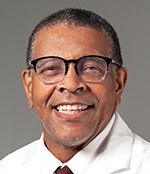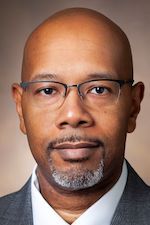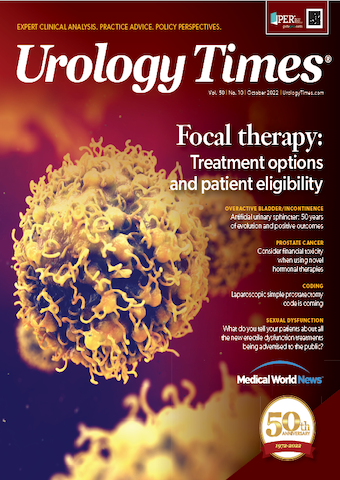Publication
Article
Urology Times Journal
Diversity in Urology: Progress made, but there is more work to be done
Tracy M. Downs, MD, FACS

In April 2021, the American Urological Association (AUA) announced the formation of its Diversity & Inclusion Task Force. More recently, the organization announced the appointment of Larissa Bresler, MD, DABMA, as chief diversity officer and Diversity & Inclusion Committee chair. In this interview, Tracy M. Downs, MD, FACS, chair of the Diversity and Inclusion Task Force, discusses his current position at the University of Virginia in Charlottesville, the role of groups such as the R. Frank Jones Urological Society and Urology Unbound, and why research must be more diverse. Downs is the chief diversity and community engagement officer and senior associate dean of diversity, equity, and inclusion (DEI) at the University of Virginia.
Kelvin Moses, MD, PhD

He was interviewed by Kelvin Moses, MD, PhD, an associate professor of urology and fellowship director of urologic oncology at Vanderbilt University Medical Center in Nashville, Tennessee.
Please describe your position at the University of Virginia.
When I was recruited, it was to be the chief diversity and community engagement officer, and that is overlooking the entire health system. It encompasses the School of Medicine, the School of Nursing, and the entire medical center. There is also a community aspect, which revolves around social determinants of health and how we are making impacts not only fiscally but with programming and initiatives. Since my arrival, our new dean, Melina Kibbe, MD, who is the first female dean at UVA School of Medicine, is very much a champion and advocate for diversity. In addition to my health system role, I’m the senior associate dean of diversity, equity, and inclusion at the School of Medicine. Those 2 titles could, to some, look like I’m just trying to amass titles, but it’s actually more about alignment and organizational structure to move diversity in the right way, and so that it’s not multiple groups doing multiple things that are uncoordinated and unaligned.
That’s awesome and congratulations; that is a major accomplishment. Can you talk about some initiatives that you want to implement?
There are a couple. The first 1 is really addressing diversity at the department level. Prepandemic, we had a group we called diversity facilitators who were charged with diversity initiatives. There was a range of accomplishments. Some were what I would call nonaspirational: Go to a meeting and learn about diversity. Others were about how we support our residents in training. I’ve repurposed that group into something called the “jedis,” or justice, equity, diversity, and inclusion strategists. That is gaining some interest and enthusiasm. That’s the group I want to be a cohort of DEI experts. If you look at the Association of American Medical Colleges data, most people in a DEI role within their departments are not allocated protected time nor fiscal resources to advance DEI work, leading to most not staying in that position long term. We’re trying to address those issues. One is by paying for time, and so we’re putting in funds out of my office and my budget in the med school, and we’re asking each department to match those funds. It’s a little bit of a positive peer pressure; it’s a way of saying, “Are you really invested in diversity? We’re putting our money here, and we are asking you to partner as well." So the first component is very much inwardly focused on recruitment and retention. But the outward, longitudinal aspect is focused on our communities with outreach and engagement. Most people dive in early, ie, Let’s get a lot of middle-schoolers to come and learn science 1 weekend, and we know that initial exposure is so far from, Be a future urologist. And so, in this role, my job is very different. But as you and I talk, I’ll discuss why I think that approach is needed, but also touch on the fact that, if it’s overly invested in from a urology perspective, I’m not so sure you get your return on investment back as it pertains to increasing the representation of diversifying the urologic workforce.
As we know, urology has had a real challenge with diversity. The AUA is starting to recognize that. I know you’ve been working with the board on some of the higher-level initiatives. Can you talk about some of the things that the AUA is doing in that area?
I feel that with what transpired with George Floyd and other people of color in our country, the analogy I’ve heard people use is, a sandstorm came through and revealed things that were there that many did not know about. For us, as surgeons of color, we’ve known about them for a while. Others had not. And now, it was almost like we were in the same incubator, and we got the same exposure, and none of us could run away from it. And so that is a signature moment for us to lead and so I think the AUA, the Urology Care Foundation, and other arms within the urology interest groups are making real, tangible efforts to advance. I cochaired the AUA Diversity and Inclusion Task Force with Simone Thavaseelan, MD, and put forth some recommendations to the board that I believe at [the 2022 AUA annual meeting], they’re actually voting on. One of these is ratification of a proposal that would lead to a position of chief diversity officer. That would be a paid position. In the inaugural launch, it would not be a board position. That was brought up; I think some of the bylaws and time to get to that point would not allow us to achieve that on this first rendition. I hope that there’s a strong interest at both the task force and board level to move that forward, but we’ll have to see when that transpires. But I think the inaugural chief diversity officer will be someone who is probably going to a lot of those meetings in an ex officio capacity and, although not technically on the board, will have a lot of influence.
Like you said, a lot of things we’ve been talking about for years are now coming to light. What role do you think the R. Frank Jones Urological Society and Urology Unbound can play in education and recruitment and enlightening the urological field?
R. Frank Jones, MD, for those who don’t know, was the first board-certified African American urologist. He was certified in 1936. Through Howard University/Freedmen’s Hospital, he trained generations of urologists. I do think that the R. Frank Jones Urological Society being an affinity group, we really do want it to be laser focused on African American trainees and growing that experience. So I think we’re just really at the tip of the iceberg; we’ve already done some of these things on an unofficial, informal capacity of mentoring our students. Urology Unbound is a national program, similar to an orthopedic pipeline/pathway program (Nth Dimensions), which mentors both African American and Latinx/Hispanic students who are interested in pursuing a career in the field of urology. This comprehensive program provides comprehensive support around the urology match process, mock interviews, and additional ways to strengthen your application for the urology match process. What Dr Shenelle Wilson at Urology Unbound has done is great. I think where the AUA and R. Frank Jones Urologic Society and Urology Unbound can continue our partnership is around mentoring in a culturally responsible and sensitive manner plus other areas that were mentioned in the recommendations from the AUA Diversity and Inclusion Task Force.
The partnerships are key, and I agree with you that I don’t know if we need to rename R. Frank Jones, but certainly make it known that it is the Black urological society. But all of the efforts that we put in include Latinx, LGBTQ women—R. Frank Jones is more than half women, I would imagine, at this point, certainly among the trainees. And so the efforts that we’re putting in through R. Frank Jones will have ramifications throughout the whole DEI spectrum.
You raise up so many excellent points that I’d like to expand upon. One of our residents at the University of Virginia presented a paper at AUA looking at if you want to diversify your field, and I’m talking specifically about urology in terms of underrepresented in medicine (URiM), and you want to also diversify your field in terms of gender, then investments like this, in Urology Unbound and the R. Frank Jones Urological Society, because the higher percentage of URiM trainees are women over men whereas if you look at non URiM, then it’s heavily more male than it is female. So this concept of intersectionality, where it’s race and gender, you accomplish your goals when you partner with Urology Unbound and the R. Frank Jones Urologic Society.
If you were to come to the AUA annual meeting 7 years from now, what would you consider either success or on the way to success from the perspective of what we’re discussing?
I think, already with AUA secretary John Denstedt[, MD, FRCSC, FACS, FCAHS], 1 of the recommendations accepted, and being voted on or confirmed, is to have an abstract session devoted to DEI topics, to see a robust presentation that really not only touches on what we would think of internally, meaning membership, but also things around our patients in our community. Should we be thinking about guidelines that are race conscious? We know that other organizations have shown, and we’ve looked at it at the University of Virginia, that different outcomes occur based on how people are admitted to different services based on their race. Race is a social construct. I totally get that; I don’t deny it. But what we see every day, we need to counteract that with being conscious and knowing how race can actually harm an individual’s care. So I think to see those things that come along, and we’re not just in the early baby steps of DEI, but we’re thinking about leadership academies, where we’re seeing a higher density of URiM urologists who are ready to be a future chair if that’s what they want to do. We should have those next steps. And hopefully when we’re walking around 7 years from now, it looks different and it feels different and we have the data to back that up.
I completely agree. I think people used to feel some pride about being “the first this” or “the only one that” and I think we’re growing out of that where, no, being the only one in the room is not acceptable, or being the only representative for everything Black is not ideal. We want to be represented. We spend a lot of time talking about disparities in medicine and outcomes, and plenty of papers are written. But then you look at the same author’s clinic, and you wonder, where are these patients you’re talking about? So I think you’re right that it needs to look and feel different. Because if it’s not, then basically, we’re doing the same thing.
I love your point. You’ve written these papers, and your clinic looks very different. But you’re right; when I think about these large database, [Surveillance, Epidemiology, and End Results]-led studies, not to be rude, but people are making careers off of the difference between Black and White prostate cancer patient outcomes, and then you would go into their clinic, or you would see who their staff was, or you’d see who they are training as fellows or residents; my point is that they are overlooking other ways to make contributions regarding diversity and inclusion, such as improving the diversity of their staff, students, and also making sure that they are intentional about providing their expert clinical care to benefit the diverse communities and neighborhoods in their towns, cities and counties. US News & World Report (USNWR) is being very forthright; there’s an interesting statistic from the 2021 USNWR that said that 4 out of the 5 best hospitals are usually providing segregated care, meaning they’re not diverse enough. There are certain centers, most of them located in the Southeast, some in the mid-Atlantic, that actually have diverse populations. And so US News & World Report asked about specific metrics around, essentially, the people who are treated in your hospital and whether they have the same demographic percentage representation as the people who live in your community. This report and metric provides an opportunity for each health system to evaluate itself around health equity and see how it can meet the needs of all of its community members.
An additional area that will hopefully encourage us to expand clinical trial enrollment to minority populations is that scientific journals are considering if an article would be considered for publication if it did not have a study population that represented the known demographics of a specific health disease category.
For instance, If you’re studying a disease, and your registry doesn’t look like what we know the population looks like, maybe you’re going have to find another journal to publish your work in. When those things start to happen, it moves beyond the traditional courtesy language that we’re both familiar with, internal review boards: “You will make sure you enroll underrepresented minorities in studies and that you’ll be respectful with regards to age and children, etc.” We know at times that language is helpful but to date has not improved the diversity of patients that are enrolled into clinical trials.
Historically, in our field some of the earliest prostate specific antigen (PSA) studies enrolled patients from St. Louis, Missouri, which has a high percentage of African Americans, yet the study had only a few African American patients who were enrolled. In my opinion, that was a missed opportunity to advance science equitably. Our lack of enrollment of a substantial number of African American patients in prostate cancer trials led to a blanket recommendation by the US Preventive Services Task Force decreasing PSA testing for all men rather than a subset of men.
We just can’t let ourselves keep doing those studies and pat ourselves on the back with an enrollment that doesn’t represent the demographics of the patients who are most commonly diagnosed with a specific urologic condition or disease. I remain optimistic with the increasing awareness around health equity through the COVID-19 pandemic and our specialty taking steps to make advances in diversity, equity, and inclusion with the same intentionality we do around providing state-of-the-art and best practices of care.

Newsletter
Stay current with the latest urology news and practice-changing insights — sign up now for the essential updates every urologist needs.






























